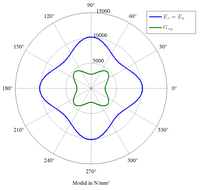Cross connection
The cross connection (short: KV ) is a combination of two unidirectional layers of a fiber-reinforced plastic. The unidirectional layer crosses the other at an angle of 90 °. The cross connection is a special case of a balanced angle connection AWV45.
From a mechanical point of view, all fabrics are cross-linked. This applies to the balanced fabrics as well as to fabrics with different numbers of warp and weft threads. A quasi-isotropic laminate is built up from cross-bonds.
commitment
Since all fabrics are cross-bonded, it is very common. It is an optimal laminate if it lies in the main stress axes. In this case, the layer thicknesses of the cross connection must be selected according to the network theory .
A case in which the principal normal stresses are of the same magnitude is the case of pure shear stress. A fabric rotated by 45 ° comes to lie in the main stress directions as AWV45. This construction is used in the push bars of spars in gliders . In the winding technology, too, cross-ties are placed as fabric tapes at 45 °. This results in rigid winding components.
properties
The cross connection is orthotropic in its axes of symmetry as a disk and plate . It has no disk-plate coupling in these axes (see classical laminate theory ). If the layer thickness is the same, the moduli of elasticity in the x and y directions are identical.
The shear modulus of a cross connection is maximum at an angle of 45 °.

